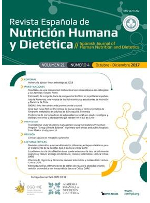Healthy eating promotion at restaurants: qualitative research, a study of Colombian cases
DOI:
https://doi.org/10.14306/renhyd.23.4.743Keywords:
Restaurants, Diet, Healthy, Food Services, Food Supply.Abstract
Introduction: Eating out has been identified as one of associated factors to the emergence of noncommunicable diseases, which is a global public health problem. In this context, the present study identified how restaurants promote healthy eating.
Material and methods: Qualitative study that adopted a case study approach. The research included 68 establishments part of the Top 100 restaurants with the highest sales in Colombia, located in the capital city. Observations and documentary review of contents exposed by restaurants on their website, official social networks and web menu were look at between April 2016 and February 2017. The analysis of the information was done for attributes in Epiinfo 7.2 and for information categorized with the Program Nvivo 11.0.
Results: Eight of the 68 restaurants declared the development of healthy eating initiatives as part of their business concept; nevertheless, other 25 establishment also implemented actions in the subject. According to the findings, restaurants promoted healthy eating through the supply of vegetables, or through messages on social networks, promoting their healthy menu items.
Conclusions: It would be beneficial a more comprehensive approach to promote healthy eating at restaurants. This not only for the food offering, but also for those mechanisms that persuade healthy choices, because few results on strategies of prices, campaigns or nutritional information were found. The results contribute to recognize characteristics of Colombian food environments, given the poor information on this and the need to work on this topic with the restaurant sector.
References
(1) Niederman SA, Leonard E, Clapp JE. Restaurant nutrition reporting and impact on surveillance. Journal of Food Composition and Analysis. 2017.
(2) Newson R, van der Maas R, Beijersbergen A, Carlson L, Rosenbloom C. International consumer insights into the desires and barriers of diners in choosing healthy restaurant meals. Food Quality and Preference. 2015;43:63-70.
(3) Levi J, Segal LM, St Laurent R, Lang A, Rayburn J. F As in fat: how obesity threatens America’s future 2012.2012.
(4) Lachat C, Nago E, Verstraeten R, Roberfroid D, Van Camp J, Kolsteren P. Eating out of home and its association with dietary intake: a systematic review of the evidence. Obesity Reviews. 2012;13(4):329-46.
(5) Todd JE, Mancino L, Lin B. The impact of food away from home on adult diet quality. USDA-ERS Economic Research Service. 2010;90:1-18.
(6) Ruopeng A. Beverage consumption in relation to discretionary food intake and diet quality among us adults, 2003 to 2012. Journal of the Academy of Nutrition and Dietetics. 2015;116(1):28-37.
(7) Mikkelsen BE. Images of foodscapes: Introduction to foodscape studies and their application in the study of healthy eating out-of-home environments. Perspectives in Public Health. 2011;131(5):209-16.
(8) Townshend T, Lake AA. Obesogenic urban form: theory, policy and practice. Health Place. 2009;15(4):909-16.
(9) Silva M. El panorama de la restauración en el país. ¿Hacia dónde va la restauración en Colombia? Panorama del sector [Internet]. 2016;73:12 de junio de 2017.
(10) Americans Spending Half of Every Dollar Going out to Eat [Internet]. 2016. Available from:http://www.aicr.org/cancer-research-update/2016/02_10/cru_Americans_Spending_Half_of_Every_Dollar_Going_Out_to_Eat.html?referrer=https://www.google.com.co/.
(11) Minaker LM, Shuh A, Olstad DL, Engler-Stringer R, Black JL, Mah CL. Retail food environments research in Canada: A scoping review. Can J Public Health. 2016;107:4-13.
(12) Dietary Guidelines Advisory Committee. Scientific Report of the 2015 Dietary Guidelines Advisory Committee [Internet]. 2015. Available from: https://health.gov/dietaryguidelines/committee/.
(13) Willett WC, Stampfer MJ. Current evidence on healthy eating. Annu Rev Public Health. 2013;34:77-95.
(14) Molina V. El estado de las guías alimentarias basadas en alimentos en América Latina y el Caribe. FAO; 2014.
(15) Bagwell S. Healthier catering initiatives in London, UK: an effective tool for encouraging healthier consumption behaviour? Critical Public Health. 2014;24(1):35-46.
(16) Sinclair SE, Cooper M, Mansfield ED. The influence of menu labeling on calories selected or consumed: a systematic review and meta-analysis. Journal of the Academy of Nutrition and Dietetics. 2014;114(9):1375,1388. e15.
(17) Hanratty B, Milton B, Ashton M, Whitehead M. 'McDonalds and KFC, it's never going to happen: the challenges of working with food outlets to tackle the obesogenic environment. J Public Health (Oxf). 2012 Dec;34(4):548-54.
(18) Ministerio de Salud y Protección Social, Universidad del Valle. Documento guía alimentación saludable. Ministerio de Salud y Protección Social. Santiago de Cali. 2013.
(19) Díaz M, Hernández M. 2019. Healthy eating and restaurants. A review of recent evidence in the literature. Ciênc. saúde coletiva [in press].
(20) Martínez-Donate AP, Riggall AJ, Meinen AM, Malecki K, Escaron AL, Hall B, et al. Evaluation of a pilot healthy eating intervention in restaurants and food stores of a rural community: a randomized community trial. BMC Public Health. 2015;15(1):136.
(21) Lee-Kwan SH, Goedkoop S, Yong R, Batorsky B, Hoffman V, Jeffries J, et al. Development and implementation of the Baltimore healthy carry-outs feasibility trial: process evaluation results. BMC Public Health. 2013;13(1):638.
(22) Anzman-Frasca S, Dawes F, Sliwa S, Dolan PR, Nelson ME, Washburn K, et al. Healthier side dishes at restaurants: an analysis of children’s perspectives, menu content, and energy impacts. International Journal of Behavioral Nutrition and Physical Activity. 2014;11(1):81.
(23) Martins AG, da Costa Proença, Rossana Pacheco, Calvo MCM, Fiates GMR. Overweight/obesity is associated with food choices related to rice and beans, colors of salads, and portion size among consumers at a restaurant serving buffet-by-weight in Brazil. Appetite. 2012;59(2):305-11.
(24) Caraher M, O’Keefe E, Lloyd S, Madelin T. The planning system and fast food outlets in London: lessons for health promotion practice. Revista Portuguesa de Saúde Pública. 2013;31(1):49-57.
(25) Crixell SH, Friedman B, Fisher DT, Biediger-Friedman L. Improving children's menus in community restaurants: best food for families, infants, and toddlers (Best Food FITS) intervention, South Central Texas, 2010-2014. Prev Chronic Dis. 2014 Dec 24;11:E223.
(26) Batada A, Bruening M, Marchlewicz EH, Story M, Wootan MG. Poor nutrition on the menu: children’s meals at America’s top chain restaurants. Childhood Obesity (Formerly Obesity and Weight Management). 2012;8(3):251-4.
(27) Edwards JS. The foodservice industry: Eating out is more than just a meal. Food Quality and Preference. 2013;27(2):223-9.
(28) Skov LR, Lourenco S, Hansen GL, Mikkelsen BE, Schofield C. Choice architecture as a means to change eating behaviour in self‐service settings: a systematic review. Obesity Reviews. 2013;14(3):187-96.
(29) Elbel B. Consumer estimation of recommended and actual calories at fast food restaurants. Obesity. 2011;19(10):1971-8.
(30) Bedard K, Kuhn P. Micro-marketing healthier choices: Effects of personalized ordering suggestions on restaurant purchases. J Health Econ. 2015;39:106-22.
(31) Maher CA, Lewis LK, Ferrar K, Marshall S, De Bourdeaudhuij I, Vandelanotte C. Are health behavior change interventions that use online social networks effective? A systematic review. Journal of medical Internet research. 2014;16(2):e40.
(32) Wakefield MA, Loken B, Hornik RC. Use of mass media campaigns to change health behaviour. The Lancet. 2010;376(9748):1261-71.
(33) Jones CS. Taking up space? How customers react to health information and health icons on restaurant menus. Journal of Foodservice Business Research. 2009;12(4):344-63.
(34) Kang J, Jun J, Arendt SW. Understanding customers’ healthy food choices at casual dining restaurants: Using the Value–Attitude–Behavior model. International Journal of Hospitality Management. 2015;48:12-21.
(35) Sualakamala S, Huffman L. Value Negotiation for healthy food selection in restaurants. Journal of Culinary Science & Technology. 2010;8(4):242-56.
(36) Kim HJ, Park J, Kim M, Ryu K. Does perceived restaurant food healthiness matter? Its influence on value, satisfaction and revisit intentions in restaurant operations in South Korea. International Journal of Hospitality Management. 2013;33:397-405.
(37) Lee K, Conklin M, Bordi P, Cranage D. Restaurants’ healthy eating initiatives for children increase parents’ perceptions of CSR, empowerment, and visit intentions. International Journal of Hospitality Management. 2016;59:60-71.
(38) Sharma S, Wagle A, Sucher K, Bugwadia N. Impact of point of selection nutrition information on meal choices at a table-service restaurant. Journal of Foodservice Business Research. 2011;14(2):146-61.
(39) Yeh MC, Ickes SB, Lowenstein LM, Shuval K, Ammerman AS, Farris R, et al. Understanding barriers and facilitators of fruit and vegetable consumption among a diverse multi-ethnic population in the USA. Health Promot Int. 2008 Mar;23(1):42-51.
(40) Lucan SC, Barg FK, Karasz A, Palmer CS, Long JA. Concepts of healthy diet among urban, low-income, African Americans. J Community Health. 2012;37(4):754-62.
(41) Dickson‐Spillmann M, Siegrist M. Consumers’ knowledge of healthy diets and its correlation with dietary behaviour. Journal of Human Nutrition and Dietetics. 2011;24(1):54-60.
(42) Hamelin A, Lamontagne C, Ouellet D, Pouliot N, O'brien HT. Healthful eating: beyond food, a global concept. Canadian Journal of Dietetic Practice and Research. 2010;71(2):e21-7.
(43) Bisogni CA, Jastran M, Seligson M, Thompson A. How people interpret healthy eating: contributions of qualitative research. Journal of nutrition education and behavior. 2012;44(4):282-301.
(44) Center for Public Health Nutrition. Working to improve nutrition, physycal activity and health in our communities [Internet]. 2017. Available from: http://depts.washington.edu/uwcphn/.
(45) Grotto D, Zied E. The standard American diet and its relationship to the health status of Americans. Nutrition in Clinical Practice. 2010;25(6):603-12.
(46) Probst L, Houedjofonon E, Ayerakwa HM, Haas R. Will they buy it? The potential for marketing organic vegetables in the food vending sector to strengthen vegetable safety: A choice experiment study in three West African cities. Food Policy. 2012 6;37(3):296-308.
(47) Reinders MJ, Huitink M, Dijkstra SC, Maaskant AJ, Heijnen J. Menu-engineering in restaurants-adapting portion sizes on plates to enhance vegetable consumption: a real-life experiment. International Journal of Behavioral Nutrition and Physical Activity. 2017;14(1):41.
(48) Hood C, Martinez A, Meinen A. Promoting healthy food consumption: a review of state-level policies to improve access to fruits and vegetables. WMJ. 2012;111(6):283-6.
(49) Abubakar I, Tillmann T, Banerjee A. Global, regional, and national age-sex specific all-cause and cause-specific mortality for 240 causes of death, 1990-2013: a systematic analysis for the Global Burden of Disease Study 2013. Lancet. 2015;385(9963):117-71.
(50) Micha R, Shulkin ML, Peñalvo JL, Khatibzadeh S, Singh GM, Rao M, et al. Etiologic effects and optimal intakes of foods and nutrients for risk of cardiovascular diseases and diabetes: Systematic reviews and meta-analyses from the Nutrition and Chronic Diseases Expert Group (NutriCoDE). PloS one. 2017;12(4):e0175149.
(51) Gobierno de Colombia. Guías Alimentarias Basadas en Alimentos para la población colombiana mayor de 2 años. Instituto Colombiano de Bienestar Familiar and FAO. 2015.
(52) American Cancer Society. Eating at fast food, full service restaurants linked to more calories, poorer nutrition. 2014.
(53) Wu HW. Unsavory choices: The high sodium density of US chain restaurant foods. Journal of Food Composition and Analysis. 2015;40:103-5.
(54) Urban LE, Roberts SB, Fierstein JL, Gary CE, Lichtenstein AH. Temporal trends in fast-food restaurant energy, sodium, saturated fat, and trans fat content, United States, 1996-2013. Prev Chronic Dis. 2014;11(12).
(55) Notice of Intention to Amend Article 81.50 of the New York City Health Code [Internet]. 2007. Available from: https://www1.nyc.gov/site/doh/about/hearings-and-notices/official-notices-archive-06-07.page.
(56) Moran AJ, Ramirez M, Block JP. Consumer underestimation of sodium in fast food restaurant meals: Results from a cross-sectional observational study. Appetite. 2017;113:155-61.
(57) Sisnowski J, Street JM, Braunack-Mayer A. Targeting population nutrition through municipal health and food policy: Implications of New York City’s experiences in regulatory obesity prevention. Food Policy. 2016 1;58:24-34.
(58) Kelly PM, Davies A, Greig AJ, Lee KK. Obesity Prevention in a city state: lessons from New York city during the Bloomberg administration. Frontiers in public health. 2016;4.
(59) Hawkes C, Jewell J, Allen K. A food policy package for healthy diets and the prevention of obesity and diet‐related non‐communicable diseases: the Nourishing framework. Obesity reviews. 2013;14(S2):159-68.
(60) Roberto CA, Swinburn B, Hawkes C, Huang TT, Costa SA, Ashe M, et al. Patchy progress on obesity prevention: emerging examples, entrenched barriers, and new thinking. The Lancet. 2015;385(9985):2400-9.
(61) Gorski MT, Roberto CA. Public health policies to encourage healthy eating habits: recent perspectives. Journal of Healthcare Leadership. 2015;7:81-90.
(62) Red de Información, Comunicación y Educación Alimentaria y Nutricional para America Latina y el Caribe [Internet]. 2013. Available from: http://www.fao.org/red-icean/temas/ambiente-alimentario/es/.
(63) World Bank. The growing danger of non-communicable diseases. Acting now to reverse course. The World Bank. 2011.











